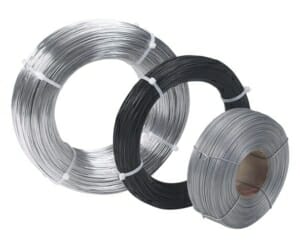The Unique Characteristics of Annealed Stainless Steel Wire
Stainless steel wire is a vital material in various industries because of its corrosion resistance, durability, and strength. Not all stainless steel wires are the same, however. Annealed stainless steel wire is particularly noteworthy due to its unique characteristics tailored for specific applications. This copy explains what annealed stainless steel wire is, how it’s made, and what differentiates it from other stainless steel wires.
What is Annealed Stainless Steel Wire and Why is it Important?
Annealed stainless steel wire is a type of wire that has been heat-treated to increase its flexibility and ductility. This process involves heating the wire to a specific temperature and then allowing it to cool slowly, which alters the physical properties of the material. The resulting wire is softer, more malleable, and easier to work with than non-annealed stainless steel wire.
This type of wire is crucial in industries where bending or shaping the material into intricate designs is necessary. It also reduces brittleness in cold temperatures while retaining corrosion resistance properties. Annealing can be performed on various grades of stainless steel such as 300 series (304L, 316L), 400 series (430) and other low- carbon materials.
For companies who require high-quality finished products or precision engineering components that require specialized tooling needs, annealed stainless steel wires are often an excellent choice due to their superior strength-to-weight ratio.
The Benefits of Using Annealed Stainless Steel Wire in Manufacturing
Annealed stainless steel wire offers several benefits over regular stainless steel wire. Firstly, it is more ductile and malleable due to the annealing process which softens the metal. This makes it easier to handle during manufacturing processes such as forming, bending, or twisting. Secondly, annealed stainless steel wire has improved corrosion resistance compared to non-annealed wires due to its uniform microstructure.
Annealed stainless steel wire is less prone to cracking or breaking during use thanks to its enhanced toughness from the annealing process. It also exhibits superior weldability properties allowing for easy joining of multiple wires.
These benefits make annealed stainless steel wire a popular choice in various industries including automotive parts manufacturing, construction and architecture projects and even in medical equipment applications where durability and performance are critical factors.
The Annealing Process: How it Affects the Properties of Stainless Steel Wire
 Annealing is a heat treatment process that alters the physical and chemical properties of stainless steel wire. The process involves heating the wire to a specific temperature and then cooling it slowly. This process helps to reduce the hardness and increase the ductility of the wire, making it easier to work with.
Annealing is a heat treatment process that alters the physical and chemical properties of stainless steel wire. The process involves heating the wire to a specific temperature and then cooling it slowly. This process helps to reduce the hardness and increase the ductility of the wire, making it easier to work with.
During annealing, the microstructure of the wire changes, resulting in improved corrosion resistance and better electrical conductivity. The process also helps to eliminate internal stresses that may have developed during manufacturing or processing.
Understanding the Different Grades of Annealed Stainless Steel Wire
Annealed stainless steel wire comes in different grades, and each grade has its unique properties that make it ideal for specific applications. One of the recognizable factors that differentiate the grades is their composition; this not only affects their physical but also their mechanical properties.
Common annealed stainless steel wire grades include 304, 316, and 321. Grade 304 is the most common type and has excellent corrosion resistance and good strength. It’s mostly used in food processing equipment, kitchen appliances, and chemical containers.
On the other hand, grade 316L contains molybdenum which improves its corrosion resistance capabilities when exposed to chlorides or acids. This makes it an ideal choice for marine applications where saltwater exposure could lead to rusting.
Finally, grade 321 features added titanium content which gives it superior high-temperature strength while still maintaining its weldability qualities. It’s suitable for use in aircraft exhaust systems or furnace components that operate at temperatures up to about 800°C.
Save Big on Annealed Stainless Steel Wire
Call 1-800-967-9697 to find how you can get more annealed stainless steel wire with Malin Co.
Applications of Annealed Stainless Steel Wire in Various Industries
Annealed Stainless Steel Wire in Medical Industry
 Annealed stainless steel wire is commonly used in the medical industry due to its excellent corrosion resistance, durability, and flexibility. One of its key applications is in surgical instruments such as forceps and scissors where it needs to be able to withstand frequent sterilization processes without corroding or deteriorating over time. Additionally, annealed stainless steel wire is also utilized in medical devices such as pacemakers and implants due to its biocompatibility with the human body. Its strength and malleability make it an excellent choice for these types of critical applications where reliability and safety are paramount concerns.
Annealed stainless steel wire is commonly used in the medical industry due to its excellent corrosion resistance, durability, and flexibility. One of its key applications is in surgical instruments such as forceps and scissors where it needs to be able to withstand frequent sterilization processes without corroding or deteriorating over time. Additionally, annealed stainless steel wire is also utilized in medical devices such as pacemakers and implants due to its biocompatibility with the human body. Its strength and malleability make it an excellent choice for these types of critical applications where reliability and safety are paramount concerns.
Annealed Stainless Steel Wire in Construction and Architecture
Annealed stainless steel wire is a popular material used in construction and architecture due to its durability and strength. It is often utilized for applications such as roof cables, handrails, fencing, and structural support. The wire’s high resistance to corrosion makes it ideal for outdoor use where exposure to harsh weather elements may occur. Additionally, annealed stainless steel wire’s aesthetic appeal complements modern architectural design schemes. Its malleability allows the material to be easily formed into various shapes making it suitable for artistic installations as well. With its versatility and longevity, annealed stainless steel wire has become a staple in the construction and architecture industries across the world.
Annealed Stainless Steel Wire in Automotive Manufacturing
Annealed stainless steel wire is widely used in automotive manufacturing for various applications. One such use is as a material for springs due to its high corrosion resistance and durability. Another application of annealed stainless steel wire in the automotive industry is in exhaust systems, where it provides excellent heat resistance and can withstand extreme temperatures. Its versatility also makes it suitable for use in fuel injection systems, body cladding, and interior components like seatbelt buckles. The strength and reliability of annealed stainless steel wire make it an ideal choice for any component that requires high-performance metal materials with exceptional durability under harsh conditions.
Annealed Stainless Steel Wire in Aerospace Applications
Annealed stainless steel wire is widely used in the aerospace industry due to its high strength and corrosion resistance. It is commonly used in the production of aircraft engines, landing gear, and other critical components. The wire’s ability to withstand extreme temperatures and harsh environments makes it an ideal material for aerospace applications. Additionally, annealed stainless steel wire is lightweight, which helps reduce the overall weight of aircraft and improve fuel efficiency. Its durability and reliability make it a top choice for aerospace manufacturers who require high-quality materials that can withstand rigorous use and maintain their integrity over time.
Tips for Handling and Storing Annealed Stainless Steel Wire
Handling and storing annealed stainless steel wire properly is crucial to maintain its quality and prevent damage. When handling the wire, it’s important to wear gloves to avoid leaving fingerprints that can cause rusting. The wire should be stored in a dry, clean area away from any moisture or chemicals that can cause corrosion. It’s also important to keep the wire in its original packaging or a similar protective container to prevent any scratches or dents. When using the wire, make sure to handle it gently and avoid any sharp bends or kinks that can weaken the material. By following these tips, you can ensure that your annealed stainless steel wire remains in top condition for all your manufacturing needs.
Choosing the Right Supplier for Your Annealed Stainless Steel Wire Needs
When it comes to purchasing annealed stainless steel wire, choosing the right stainless steel wire supplier is crucial. Look for a supplier that has a good reputation in the industry and has experience working with stainless steel wire. It’s also important to ensure that the supplier offers a variety of grades and sizes of annealed stainless steel wire to meet your specific needs.
In addition, consider the supplier’s lead times and delivery options. Will they be able to provide you with the wire you need in a timely manner? Do they offer expedited shipping options if needed?
Another important factor to consider is the supplier’s customer service. Do they have knowledgeable representatives who can answer your questions and provide technical support if needed? Do they have a return policy in case there are any issues with the product?
Annealed stainless steel wire is a crucial component in various industries, from construction to medical equipment manufacturing. Understanding the process of annealing and the different grades of stainless steel wire can help you choose the right material for your specific application. Proper handling and storage of annealed stainless steel wire is also essential to ensure its quality and longevity. When selecting a supplier for your annealed stainless steel wire needs, consider factors such as experience, quality control measures, and customer service. By following these guidelines, you can ensure that you are using the best possible material for your project or product.
FAQs About Annealed Stainless Steel Wire
What Is Annealing Stainless Steel?
Annealing is a heat treatment process employed to modify the physical and sometimes chemical properties of materials, and it is commonly utilized for stainless steel. The objective of annealing stainless steel is to reduce hardness, enhance ductility, relieve internal stresses, and improve certain mechanical properties. This process involves heating the stainless steel to a specific temperature and then gradually cooling it, resulting in alterations to its microstructure.
Heating:
The initial step in annealing is heating the stainless steel to a precise temperature. For 304 stainless steel, a common annealing temperature is typically in the range of 1900 to 2050 degrees Fahrenheit (1038 to 1121 degrees Celsius). This temperature range may vary depending on the specific alloy composition and the desired outcome.
Soaking:
Once the target temperature is reached, the stainless steel is held at that temperature for a specific duration. This soaking period ensures that the entire cross-section of the material attains thermal equilibrium, allowing for consistent heat treatment throughout.
Cooling:
Following the soaking phase, the material is slowly cooled. This controlled cooling process is often conducted in a furnace or controlled environment. The gradual cooling allows for the desired changes in the microstructure of the stainless steel.
The annealing process imparts several important characteristics to stainless steel. It reduces hardness, making the material more malleable and easier to work with. Ductility is improved, enabling the stainless steel to withstand bending and deformation without fracturing. Annealing also relieves internal stresses, preventing distortion or cracking. Additionally, the grain structure of the material is influenced, resulting in a more uniform and refined microstructure.
Annealing is a crucial step in the production of stainless steel components, particularly those requiring forming, machining, or welding. Different grades of stainless steel may have specific annealing temperature ranges and procedures tailored to their compositions and intended applications.
What Is Annealed Steel Good For?
Annealed steel, resulting from the heat treatment process of annealing, finds application in various industries and processes. Its softened state makes it particularly suitable for machining and forming operations, allowing for easier cutting, drilling, and shaping without excessive tool wear. Welding applications benefit from the improved ductility and reduced hardness of annealed steel, reducing the risk of cracking during the welding process. Additionally, annealed steel is well-suited for cold working processes such as forging and drawing due to its enhanced ductility.
The stress relief achieved through annealing makes it a preferred choice for components where internal stresses must be minimized to prevent distortion or failure. Common uses include the production of wire products, where annealed steel wire is employed in applications like springs, fasteners, and wire forms. Furthermore, annealed steel serves as a suitable material for tool manufacturing, providing ease of machining and reduced tool wear. It is often utilized as a starting material for subsequent forging and heat treatment processes due to its softened and more malleable state. Overall, the versatility of annealed steel makes it valuable in a range of manufacturing and fabrication tasks.
Can Stainless Steel Wire Be Annealed?
Yes, stainless steel wire can be annealed. Annealing is a heat treatment process that involves heating the material to a specific temperature and then cooling it slowly to modify its microstructure. The goal of annealing stainless steel wire is to reduce hardness, improve ductility, relieve internal stresses, and enhance certain mechanical properties.






